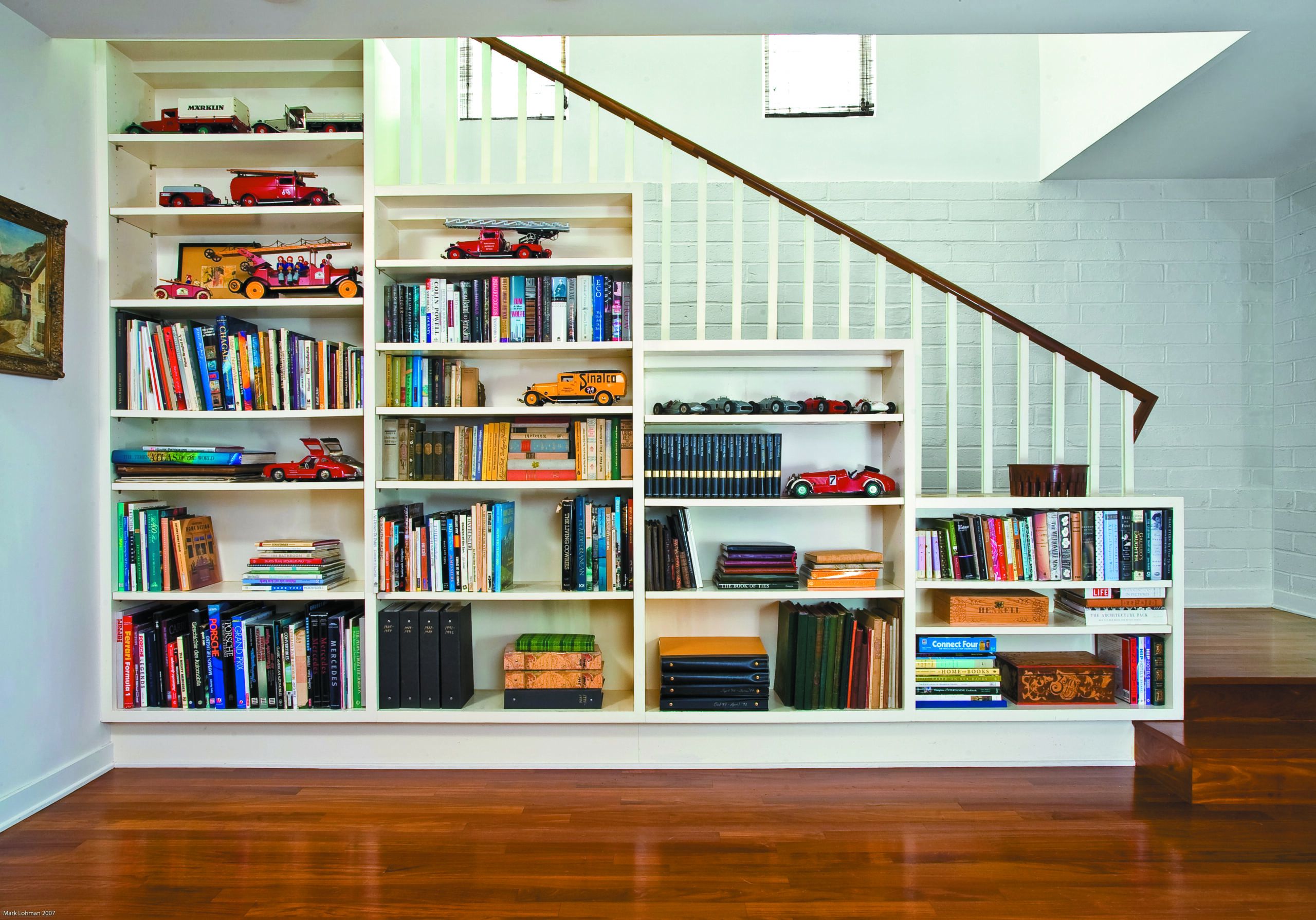Nothing uses your square footage better than built-in storage solutions. These custom-designed features seamlessly blend form and function to maximize every inch of available space. From clever under-stair compartments to stylish bookcases framing fireplaces, built-ins offer a myriad of possibilities to transform underutilized spaces into functional storage havens.
Storage Shelves Beneath a Stairway
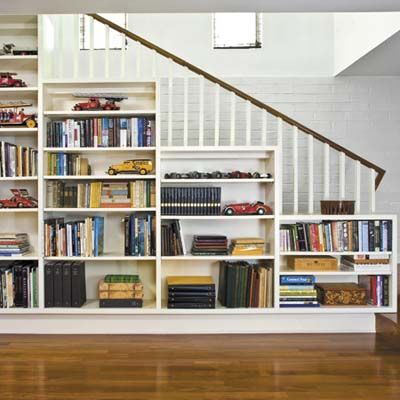
One of the primary advantages of built-ins is their ability to convert dead zones into practical spaces. Here, a clever built-in solution makes use of the space along a basement-level staircase. The descending height of these bookshelf units perfectly mirrors the slope of the staircase so that no space is wasted.
Another hallmark of built-in storage is the bespoke design approach. Built-ins can be crafted to complement existing architectural elements, such as crown molding and wainscoting, for a cohesive look. In this case, clean lines and a classic white finish create a sense of order and elegance. The open shelving design allows for easy access, while the minimalist style elevates everyday items into display pieces.
Constructed from solid 1½-inch lumber, these shelves are robust enough to support heavy loads of books, art pieces, and display items. The varying shelf heights can accommodate items of different sizes, from large art books to small decorative boxes. You could even incorporate closed cabinets or drawers to store less visually appealing items that need a little extra protection.
Storage Alcoves for A Workstation
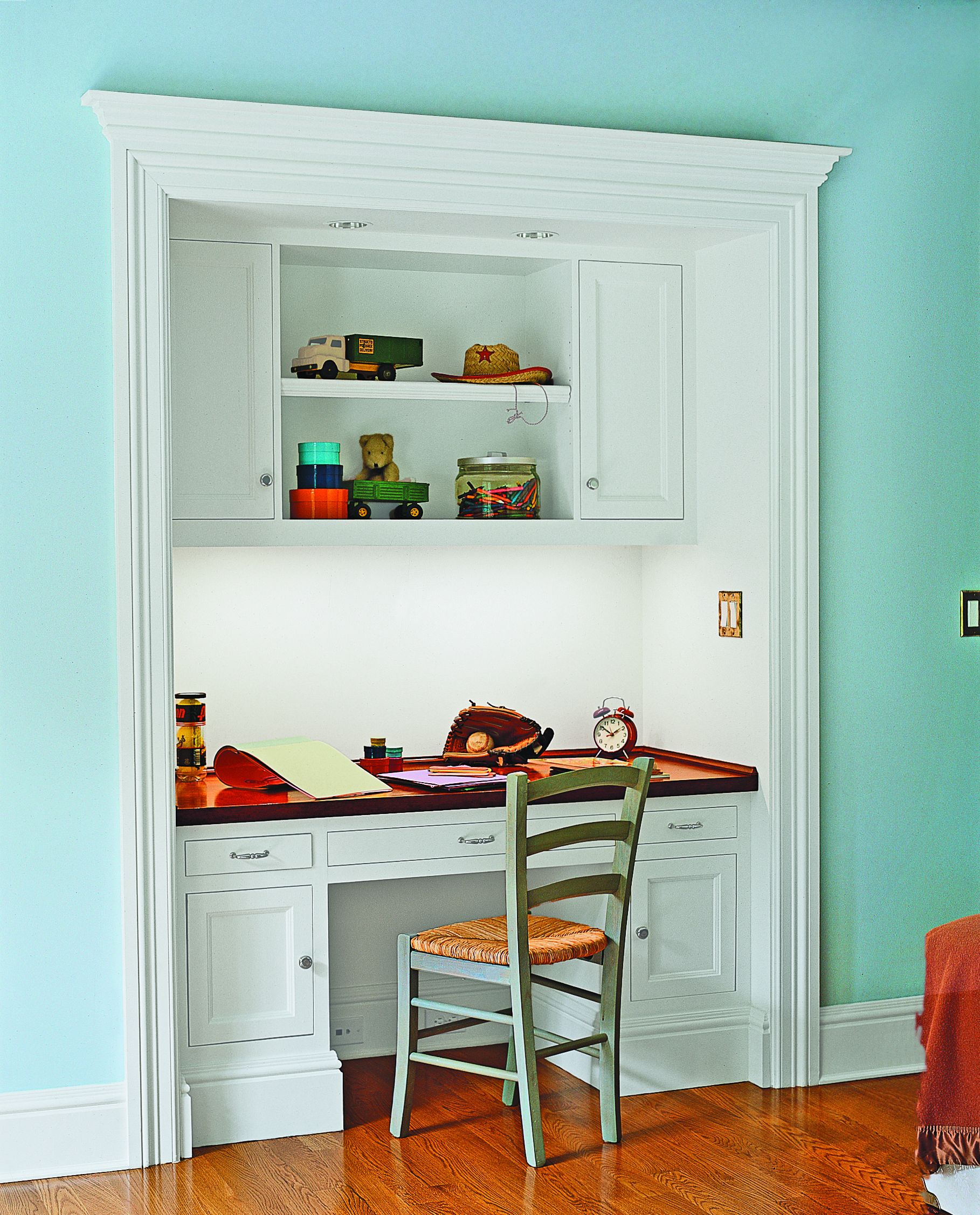
This homework alcove, designed by architect Jay Haverson, exemplifies how a recessed built-in can maximize floor space while providing a functional work area. Haverson cleverly integrated a desk and overhead storage into an alcove between a clothes closet and a bathroom. Similar setups can be achieved by repurposing existing closets or creating a bump-out from an adjoining room or by creating a bookcase alcove.
A built-in desk for a child’s room will need to change as they grow. For instance, this desk is sized appropriately for a young user at about 27 inches off the ground, compared to the standard 30 inches for adults. However, the design allows for easy adjustment as the child grows—the desk top can be raised and mounted on fillers to accommodate changing needs.
Here are a few key design elements to incorporate into your homework alcove:
- Accessible power: Include power outlets, light switches, and data lines within easy reach.
- Adjustable components: Use adjustable shelving to accommodate changing storage needs over time.
- Built-in lighting: Incorporate recessed cans or puck lights to save desk space. Use high-intensity, long-lasting xenon bulbs.
- Bulletin board: Install a cork panel on the back wall for pinning notes and artwork, or cover the wall with chalkboard or whiteboard paint.
Remember, while a homework station is an excellent addition to a child’s bedroom, a built-in desk can be equally valuable in a home office or den.
Concealed Bar Cabinet Storage
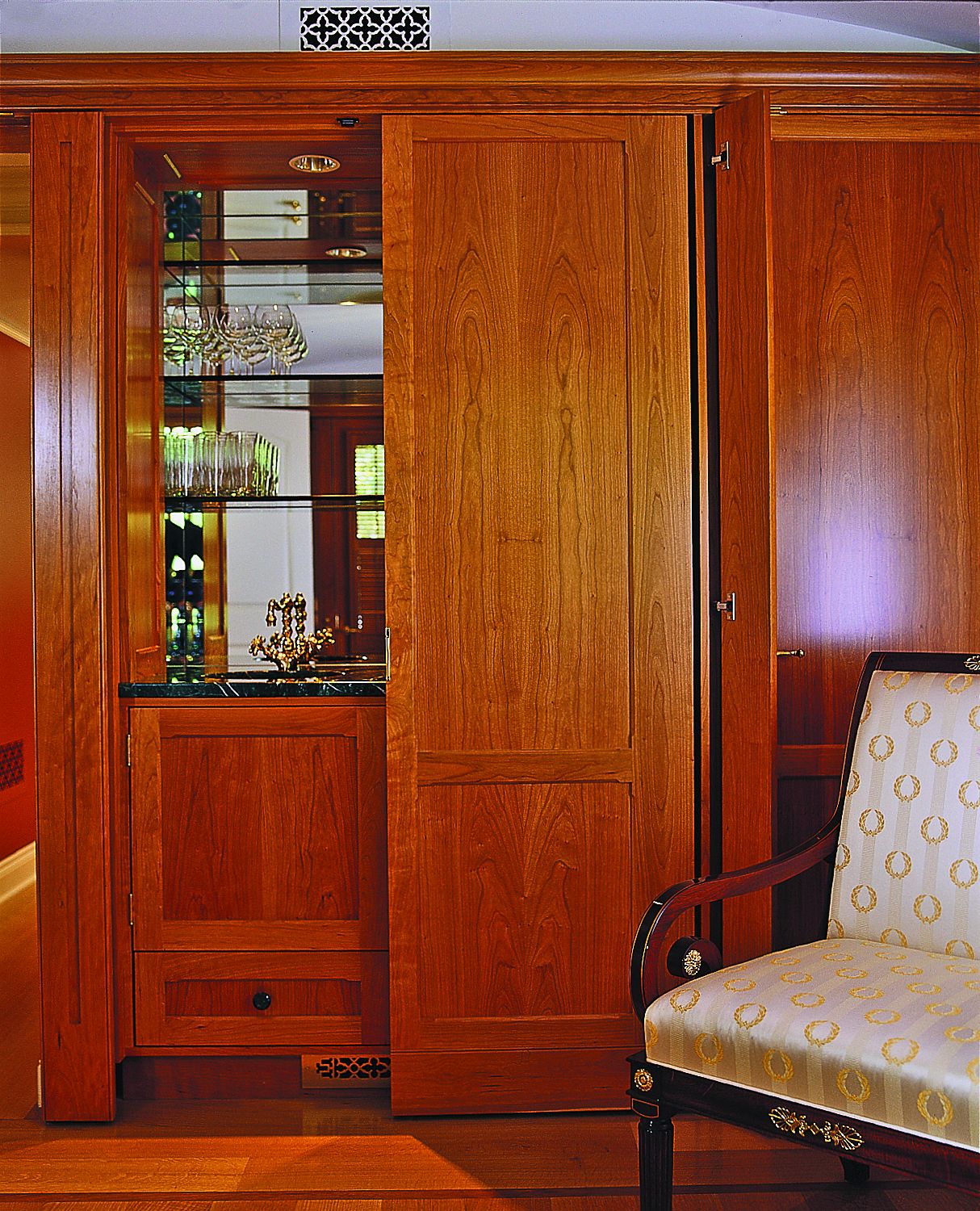
A built-in concealed behind doors can be the perfect hideaway for prep stations or serving areas. Cleverly tucked into an elegant sitting room, this sophisticated built-in wet bar designed by architect Stuart Disston keeps cocktail ingredients handy while maintaining a sleek and streamlined aesthetic.
When closed, the bar’s mini fridge, sink, glassware, and liquor bottles are completely hidden behind doors that blend perfectly with the surrounding cherry wall paneling. This design approach ensures the bar doesn’t detract from the room’s overall ambiance when not in use.
A few thoughtful design elements will further enhance the visual and practical appeal of your built-in wet bar. For instance:
- Concealed lighting: Incorporate LED strip lighting under shelves or cabinets for a warm, inviting glow.
- Durable surfaces: Choose materials like quartz or granite for countertops to withstand spills and frequent use.
- Mirrored backsplash: A mirrored panel above the bar will add depth to both the bar area and the room.
- Specialized storage: Include custom racks for wine bottles and slots for stemware to maximize organization. Adding built-in storage for glasses and dinnerware is a great way to elegantly store fragile items.
When opened, the doors of this wet bar slide back into recesses on either side of the bar and then disappear behind hinged trim boards. However, you could also hide the bar behind a fold-down or lift-up countertop, disguise it as a cabinet, or camouflage it within a bookcase.
Stand-Up Desk With Built in Storage
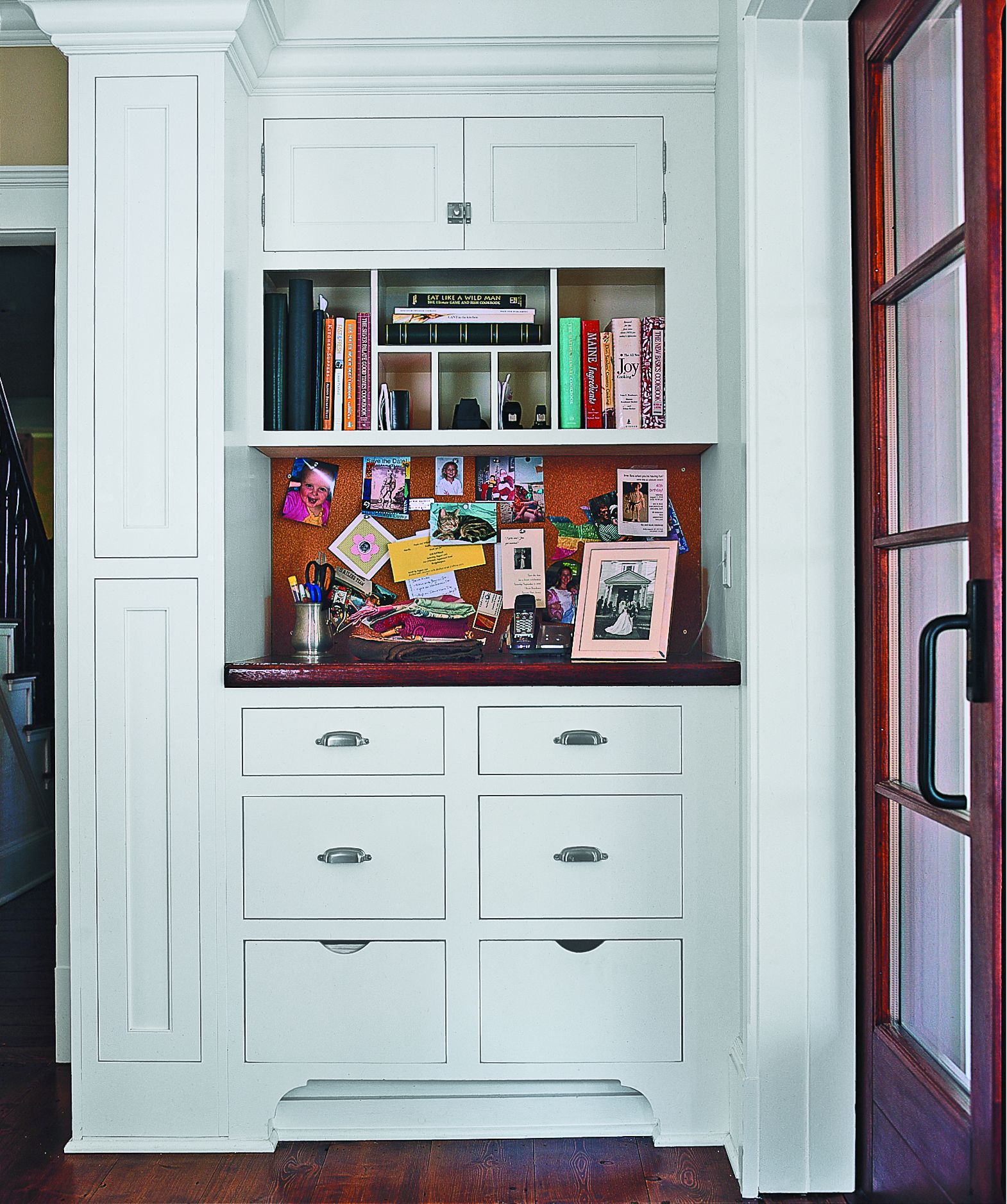
The versatility of built-ins allows for creative solutions tailored to specific needs and space constraints. This stand-up desk, designed by Scott W. Smith, demonstrates how a compact workstation can be integrated into a kitchen without impeding traffic flow.
Instead of a traditional sit-down desk that would occupy valuable floor space, this stand-up command center is cleverly tucked into a narrow wall section between the hallway entrance and doors leading to a screened-in porch. The absence of a chair keeps the high-traffic area clear while freeing up more space for storage.
Key features of this stand-up desk include the following:
- Additional shelving: Floor-to-ceiling shelves on the hallway side create even more usable space.
- Aesthetic details: A recessed toe kick on the kitchen-facing side lends an elegant, furniture-like appearance.
- Customized compartments: The shallow top drawers are perfect for office supplies, while the middle drawers accommodate hanging files, and the bottom drawers hold recyclables.
- Overhead organization: Cubbies above the desktop offer convenient storage for mail and cookbooks, and latched doors at the top provide a discreet space for less frequently used items.
- Tiered storage: Three rows of drawers beneath the 36-inch-high stained-wood countertop provide ample organization options.
Most stand-up desks fall between 38 and 46 inches tall, but you can adjust the height to comfortably suit whoever uses it. Include built-in cable management solutions and easily accessible power outlets in your design. You can also add a footrest or anti-fatigue mat to make extended use more comfortable.
Under-Window Storage Cabinet
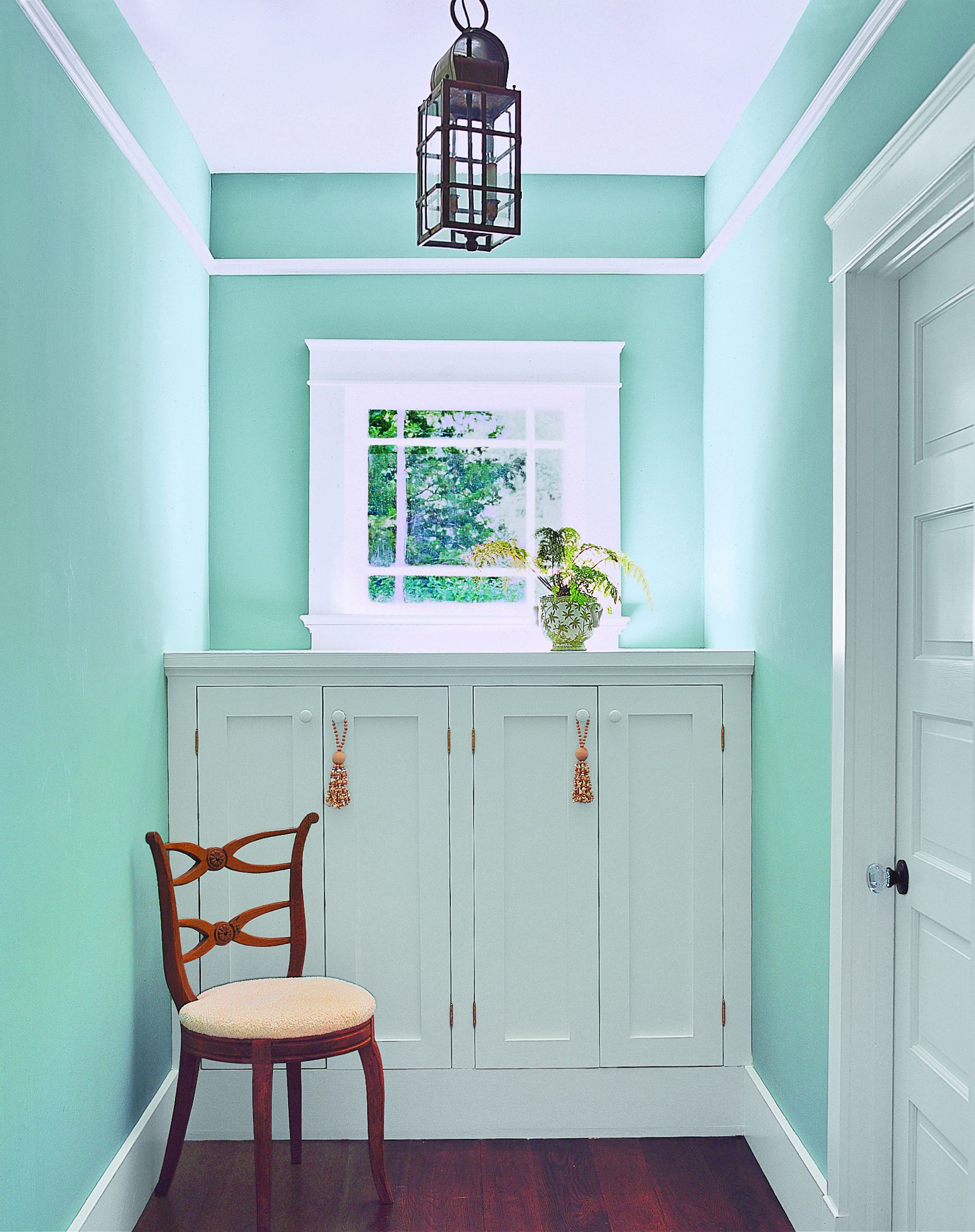
Creative built-in designs can transform the often-overlooked space beneath windows into valuable storage. Architect Anthony Vermandois showcases this potential in his renovation of a 1920s Craftsman-style bungalow, where an under-window cabinet adds both functionality and visual appeal.
This chest-high cabinet provides storage for family china while preserving the room’s airy feel. Positioned directly under the sill, it creates a more balanced focal point at the end of a long hallway, adding visual weight to what might otherwise be considered an undersized window.
When incorporating under-window cabinets, consider these design elements:
- Built-in seating: Add a cushioned top to create a cozy window seat in bedrooms or living areas.
- Custom depth: While this example is deep enough for china storage, shallower cabinets can work well in hallways or bathrooms.
- Matching trim: For a seamless look, remove existing baseboards and crown molding before installation, then extend new matching molding around the built-in.
- Open shelving: Design the cabinet with a mix of closed storage and open shelving for a more open feel.
Under-window cabinets can be customized to perfectly complement a room’s style and cater to specific storage requirements. They can also make a small window appear larger and provide extra seating without taking up extra floor space.
Columned Room Divider With Built in Storage
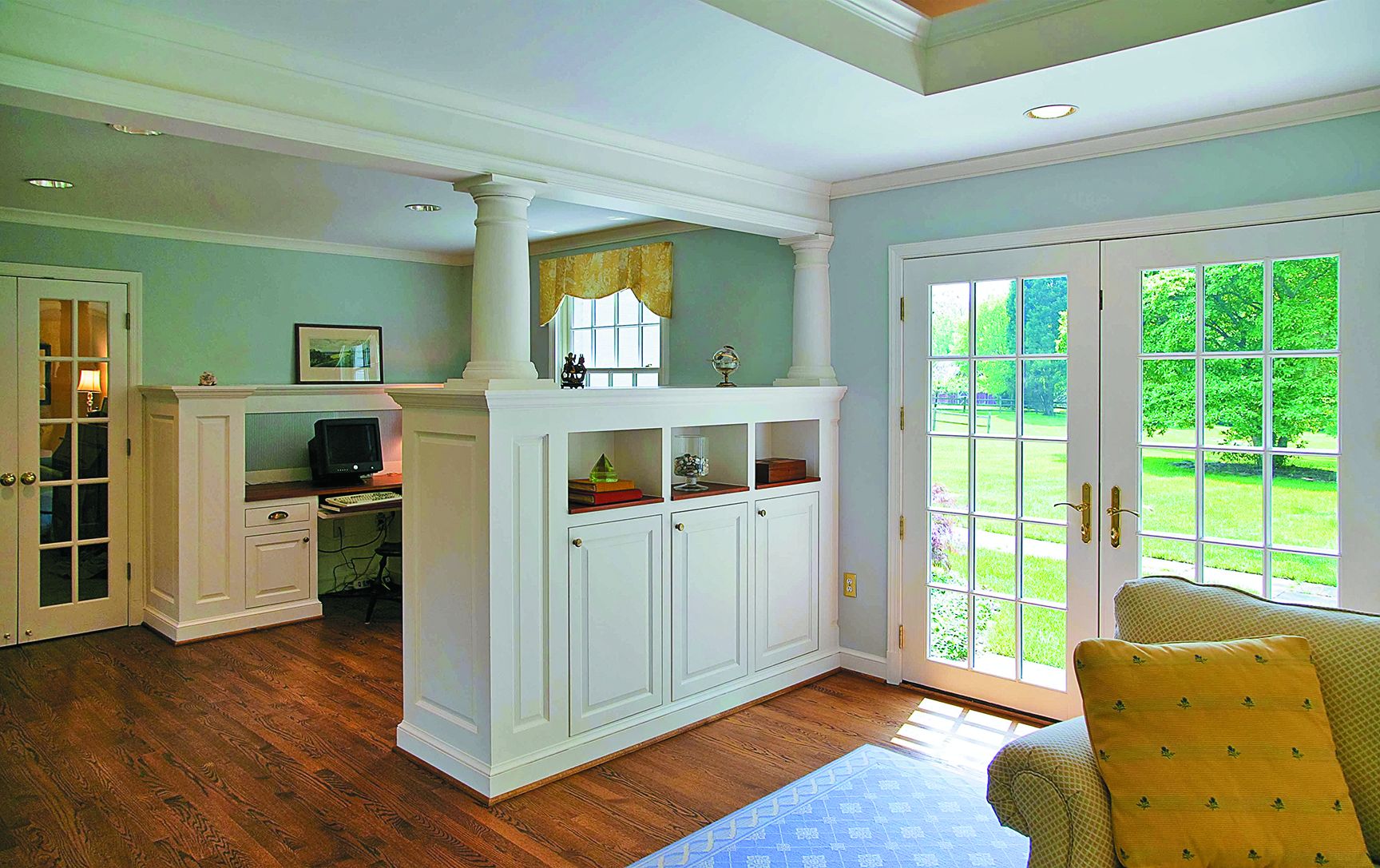
In spacious rooms, built-in dividers can elegantly define separate areas without compromising the open feel. This columned room divider, designed by architect Mark Hughes for a Colonial Revival-style home, demonstrates how built-ins can create intimate spaces within larger rooms while maintaining a sense of openness.
The homeowners wanted to carve out a private study area within their expansive great room. Rather than erecting a solid wall, Hughes designed a less imposing columned divider with integrated bookshelves and cabinets. This solution preserves the great room’s ambiance while delineating cozy living and working spaces.
A few key features make this columned divider especially effective:
- Dual-sided functionality: The office side features study carrels and shelves for legal books, while the living room side offers open cubbies and closed cabinets.
- Material contrast: Natural cherry wood lines the living room-facing cubbies, adding warmth and visual interest.
- Open-top design: A wide, open area at the top maintains visual continuity between spaces.
- Structural integration: The hollow wooden column conceals a 3-by-4-inch steel post that supports the ceiling load and upper floor.
You can design your own built-in room divider to complement the style and use of your space. Try to strike a balance between openness and privacy. For instance, you can adjust the height and density of shelving to control sightlines and sound transmission between spaces. Make sure the divider doesn’t impede traffic flow and blend seamlessly with your home’s architectural elements and decor.
Stair-Wall Wine Cellar
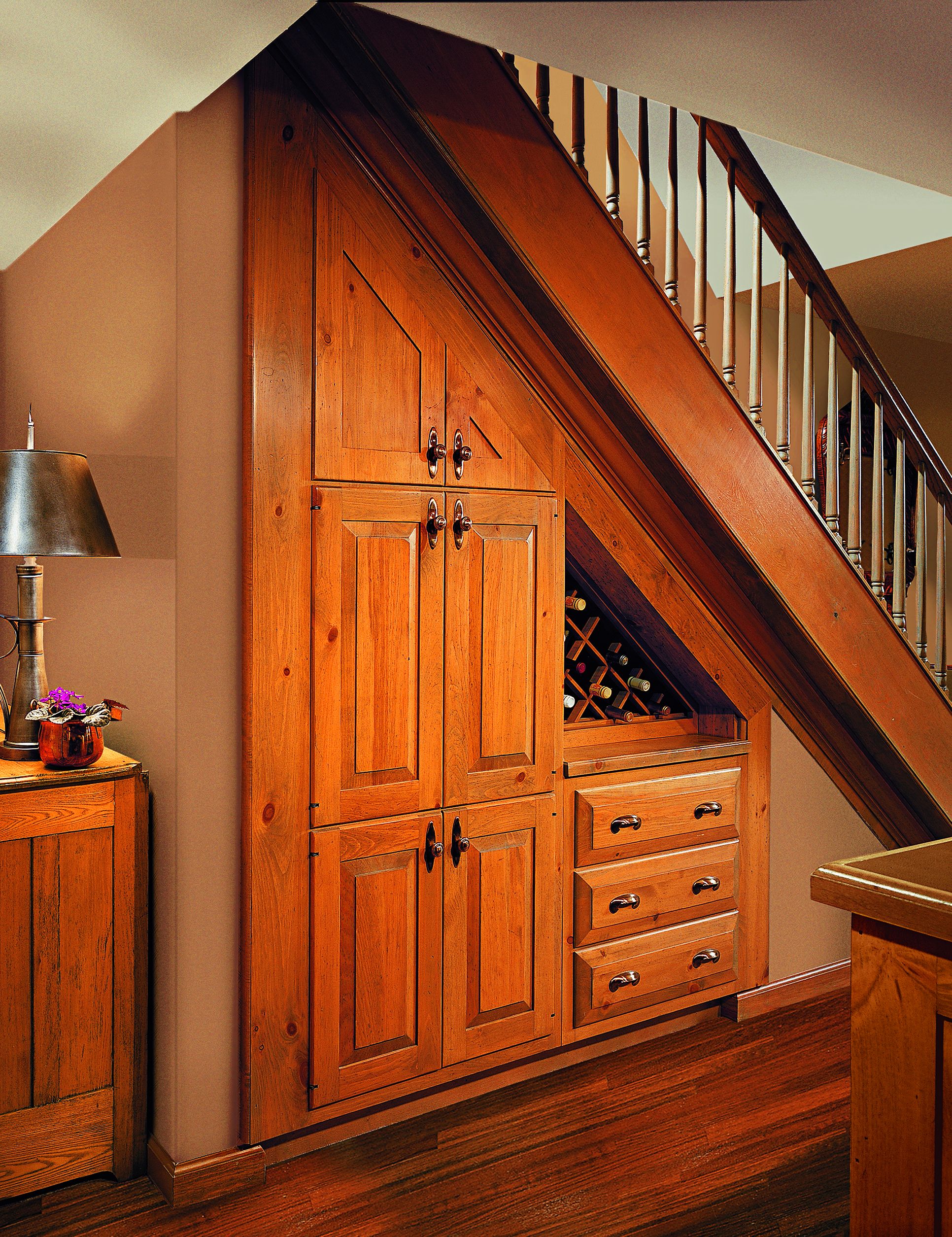
Creative built-in solutions can turn the unused space beneath stairs into a stylish focal point that serves a practical purpose. This stair-wall wine cellar, designed for a kitchen, conceals glass decanters and stemware within stained-pine cabinetry. Drawers store accessories like corkscrews and coasters, while an X-frame wine rack fills one triangular space.
John Troxell, director of design at Wood-Mode, notes, “Getting a proper fit all depends on how well you can measure and get the dimensions to work out.” His company filled most of the triangular space with standard rectangular cabinets and drawers—only the top cabinet and bottle rack required special cuts. Wide trim boards on the top and sides help conceal any gaps where the cabinets meet the wall cavity.
When designing a stair-wall wine cellar, think about these tips:
- Bottle orientation: Design racks that allow bottles to be stored horizontally to keep corks moist.
- Climate control: If storing fine wines, incorporate a small cooling unit to maintain comfortable temperature and humidity.
- Lighting: Add LED lighting to showcase your collection and create ambiance.
- Versatility: Include adjustable shelving to accommodate various bottle sizes and shapes.
Depending on the size of the space, you could even add a mini fridge or small cooling unit to your stair-wall wine cellar.
Fireplace Storage Niche
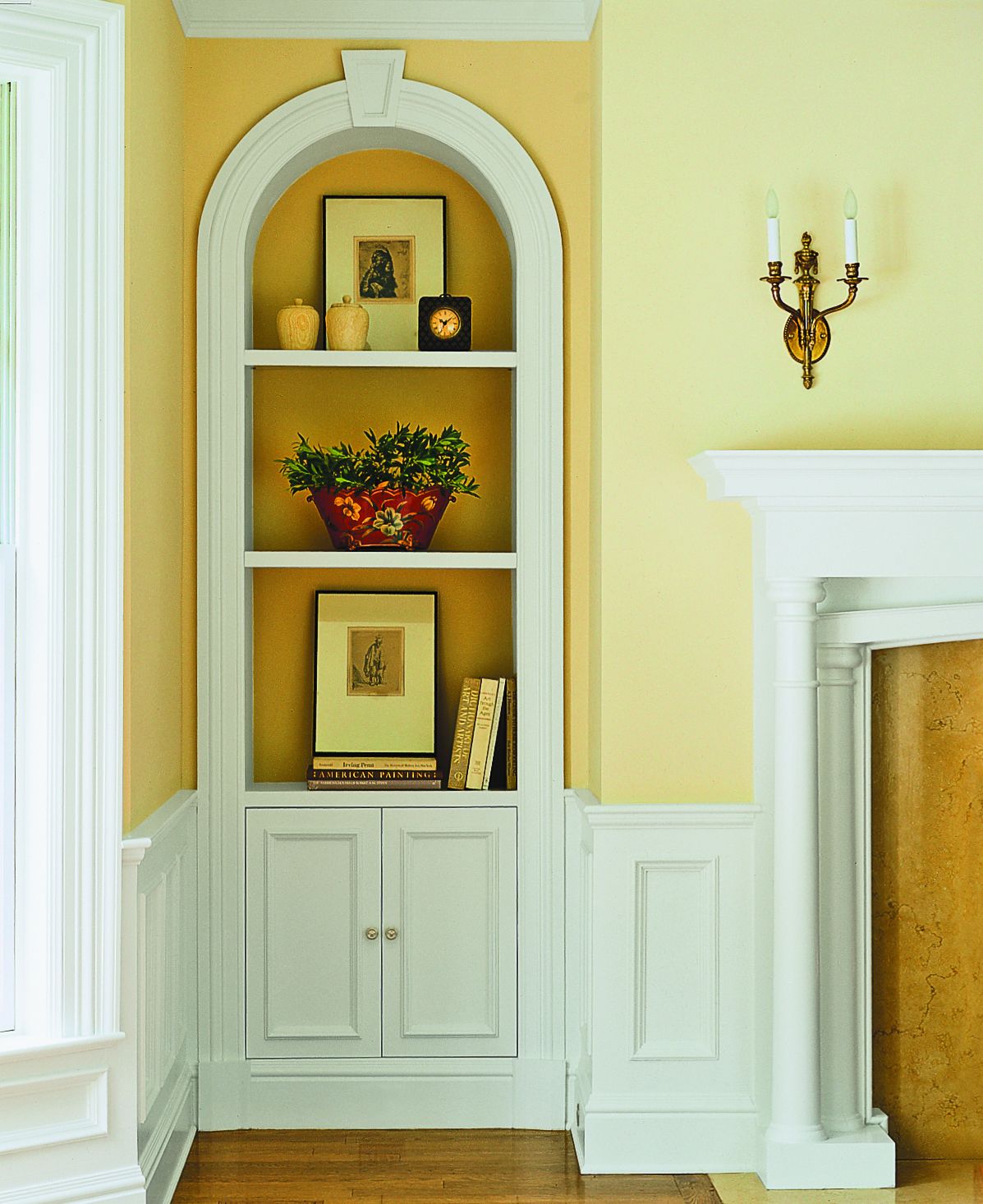
Fireplace bump-outs naturally create recesses on either side. This niche, designed by architect Jay Haverson for a newly constructed home, showcases how these spaces can be converted into built-in bookshelves or media storage.
Haverson’s design features an open display case with a closed cabinet underneath and an arched top reminiscent of early American interiors. While traditional niches often have curved backs, this modern interpretation uses a squared-off back to accommodate standard-sized books and decor items.
When incorporating a fireplace niche into your home, here are some design tips:
- Balance symmetry: If possible, create matching built-ins on both sides of the fireplace for a cohesive look.
- Consider material consistency: Use materials that complement or match the fireplace surround and mantel.
- Incorporate lighting: Add recessed lighting or sconces to highlight displayed items and create ambiance.
- Plan for technology: If using the niche for entertainment equipment, include proper ventilation and cable management.
To make the most of your fireplace niche, tailor its design to the room’s function. For instance, if the space is used for entertaining, prioritize open shelving to showcase decorative items and books, while a home office might benefit from closed cabinets for concealed storage. To add a touch of personalization, line the back of the niche with a contrasting paint color or wallpaper to create a visually striking backdrop for your displayed items.
Mudroom Storage Bench
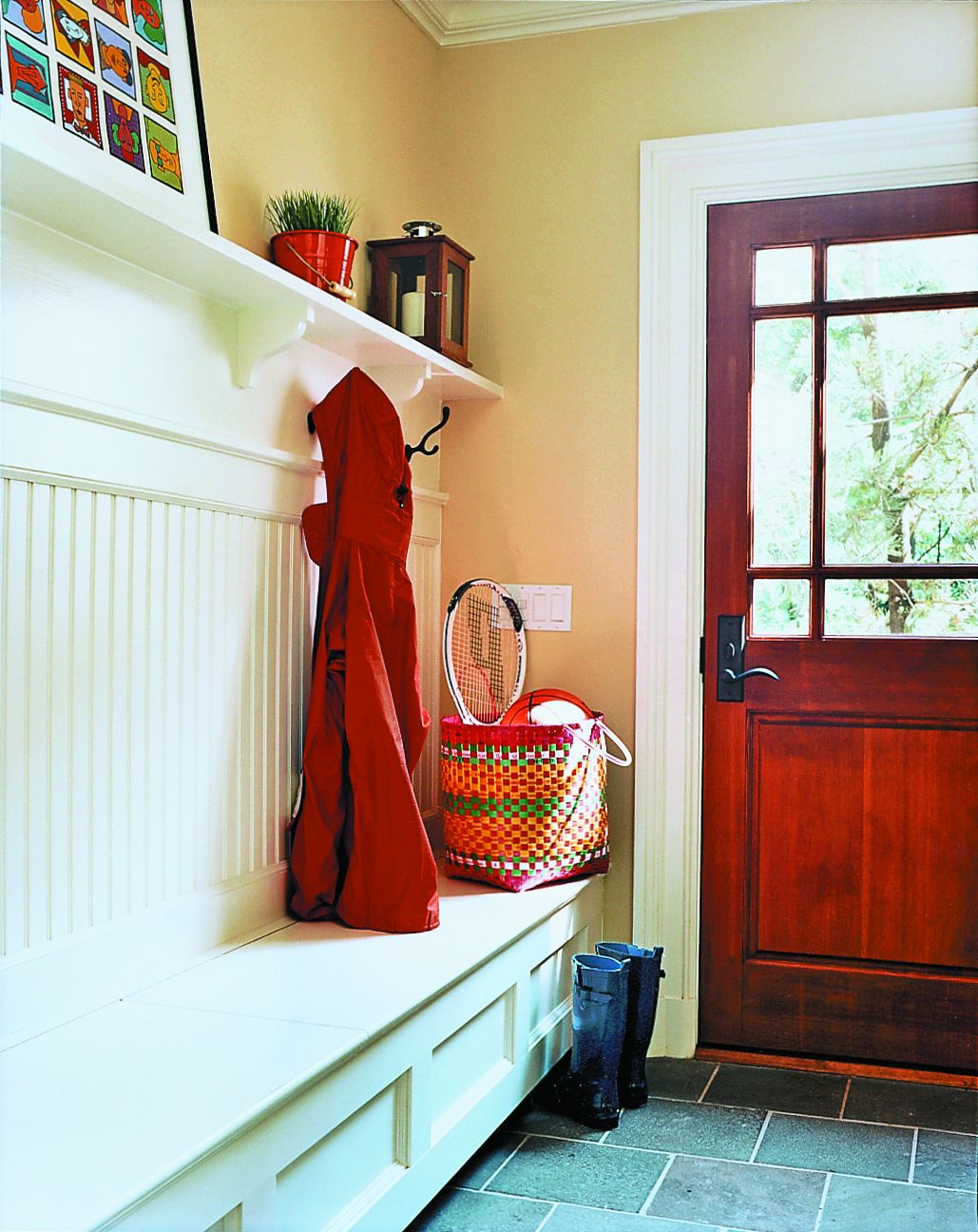
Entryways are notorious clutter magnets, but well-designed built-ins can transform these spaces into organized, functional areas. This mudroom bench, part of a 1908 home renovation by architect Carol Kurth, exemplifies how built-ins can create an efficient drop-off point for all seasons.
Kurth’s design features a hinged-top bench, a 12-inch deep top shelf, and hooks for hanging jackets, umbrellas, and pet leashes. The large interior cavity of the bench accommodates various gear, from soccer balls to swim equipment, while a sliver of space underneath can be used to tuck away shoes and boots.
Here’s what to include when designing your own mudroom bench:
- Durable materials: Choose oil-based paints for surfaces that will see heavy use, such as benches and shelves.
- Individual cubbies: Assign spaces for each family member to encourage organization.
- Proper ventilation: Design airflow to prevent odors from damp clothing or shoes.
- Weather-resistant features: Include a tray for wet umbrellas or boots near the entrance.
Remember to customize this built-in to suit your needs. For instance, you may be better served by a set of pull-out baskets or drawers than toybox-like storage with a lift-up lid. You might also add a built-in mail sorter, key hooks, or a wall-mounted basket for pocket contents.
Wall-Ordered Wardrobe
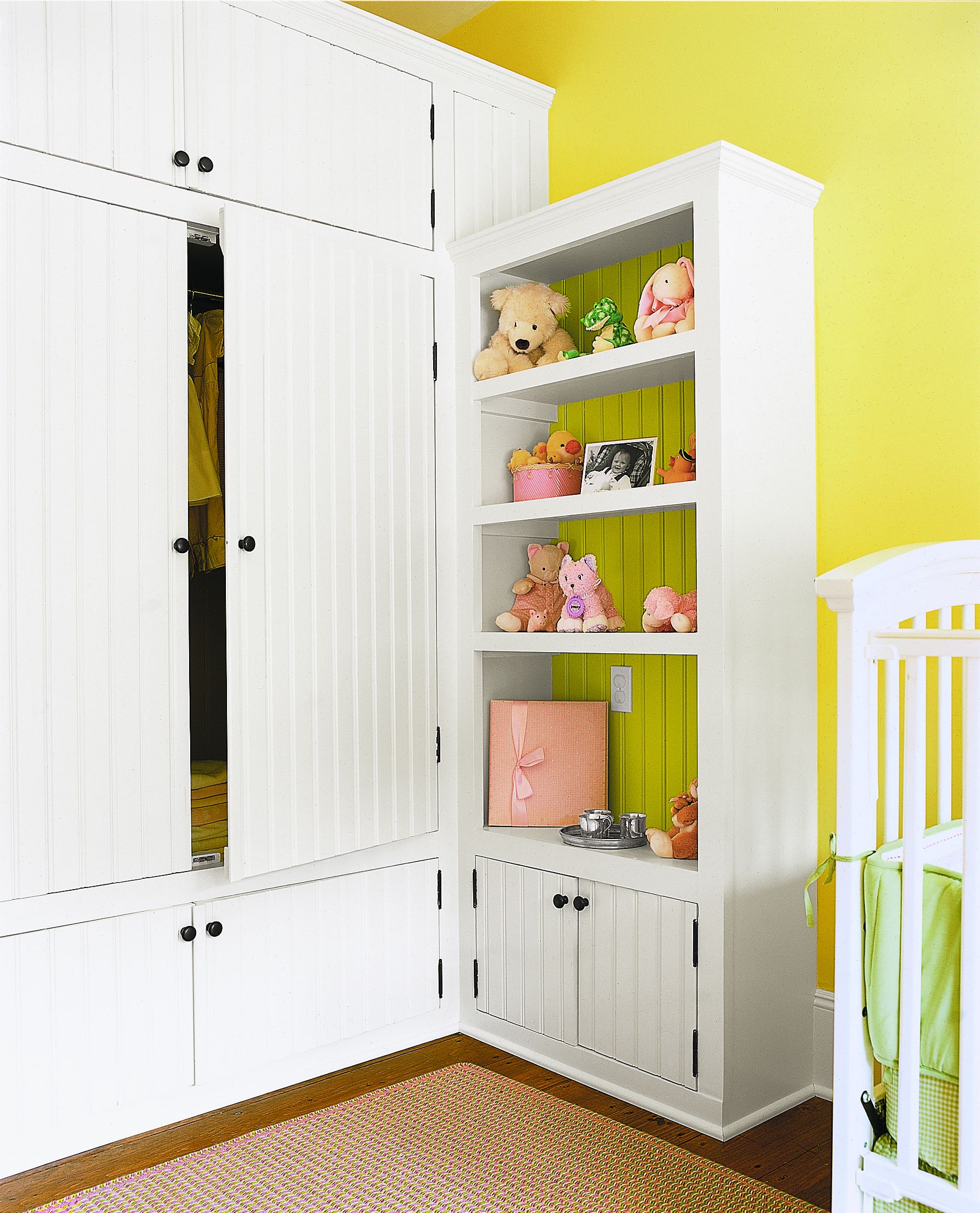
Older homes often lack adequate closet space, but built-in wardrobes can provide an elegant solution. This wall-ordered wardrobe, designed by architect Anthony Vermandois for an 1880s Folk Victorian farmhouse, offers a fresh take on the traditional floor-to-ceiling wardrobe.
Instead of spanning an entire wall, this design only takes up one corner. The wardrobe and stepped-down shelving create visual interest and a furniture-like appearance that doesn’t overwhelm the room. The wardrobe is 24 inches deep to accommodate standard clothes hangers. Rustic beadboard paneling on both the bookshelf and wardrobe complements the home’s farmhouse style.
Here are a few things to think about as you design your own built-in wardrobe:
- Lighting and ventilation. Add LED strips or puck lights to illuminate the interior and small vents or louvered sections to prevent mustiness.
- Matching trim: Incorporate crown molding or decorative trim that echoes the room’s style to blend your wardrobe into the existing architecture.
- Versatile storage: Mix hanging space with drawers and shelves to give yourself plenty of options. Adjust shelf heights and rod placements to suit your wardrobe.
Install a built-in full-length mirror on the inside or outside of one of the wardrobe doors. You can also incorporate a fold-down ironing board, pull-out valet rod, or similar accessories to streamline your morning routine.
Dressing-Room Storage
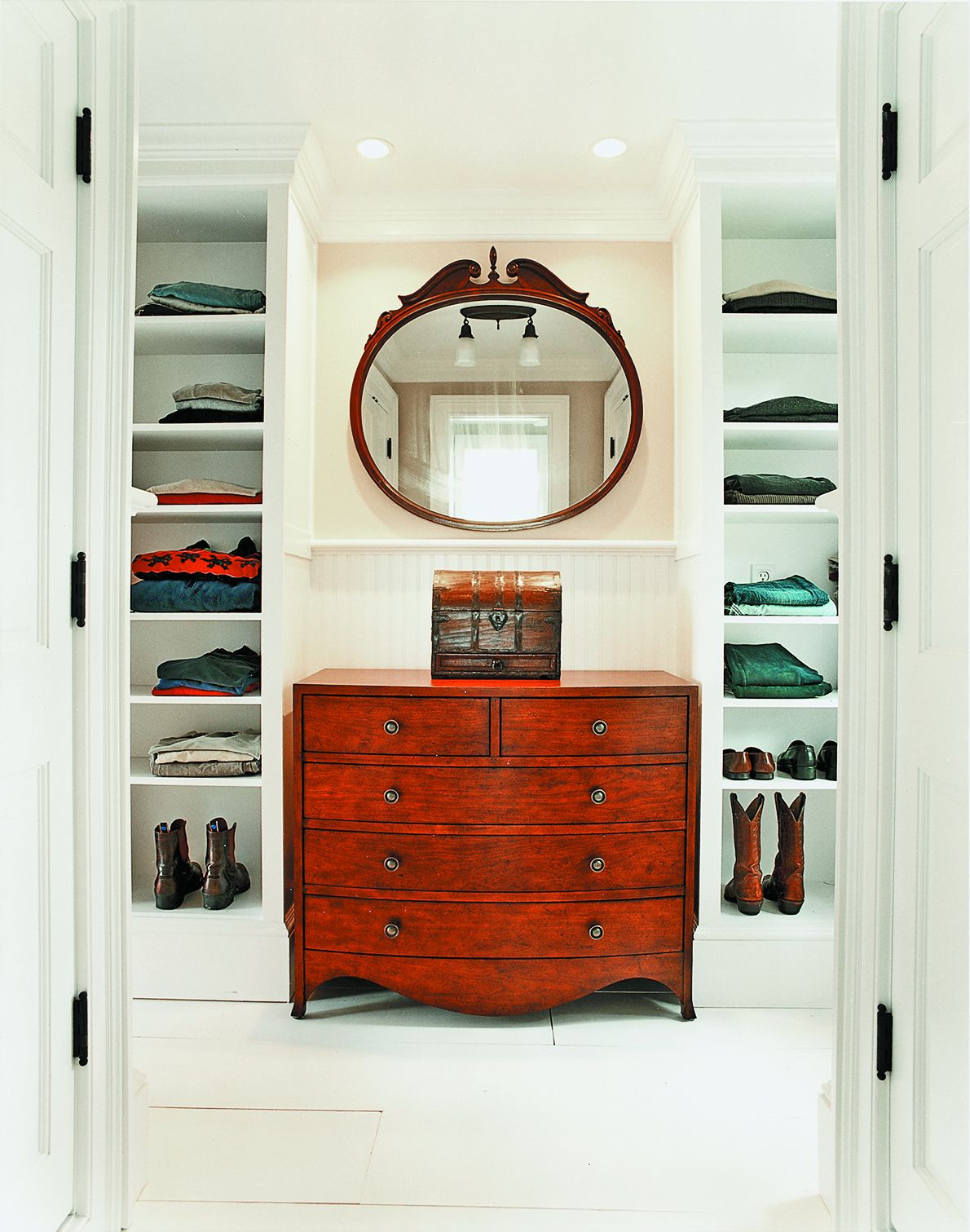
Built-ins that create alcoves for freestanding furniture can highlight special pieces while maximizing storage. This dressing room, designed by Rick and Liz O’Leary during an 1840s farmhouse renovation, demonstrates how to integrate an antique chest of drawers into a walk-in closet’s built-in shelving.
The design features tall shelving units flanking the chest, framing it with just two inches of clearance on either side. The shelving units blend seamlessly with the room’s decor and give the freestanding chest of drawers a sense of permanence and purpose.
When designing your own dressing-room shelving, be sure to choose materials that harmonize with the overall style of the room. Mix built-in and freestanding pieces, and light the area to highlight both features. For a truly personalized and luxurious experience, incorporate a pull-out mirror or hidden jewelry drawer into the built-in shelving.
